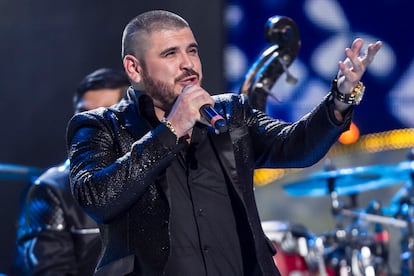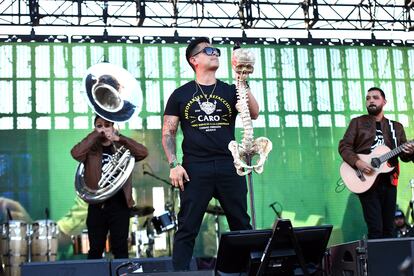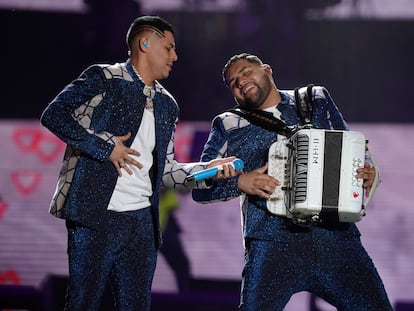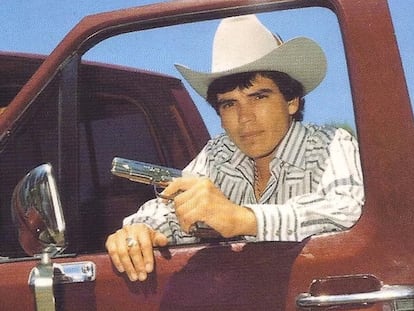The return of the altered corridos, the musical movement that made Mexico dance (and tremble)
The musical subgenre seeks to resume the narration of stories through song, which detail eccentric lives, luxuries, as well as the violence that permeated the style and way of life of those growing up in the early 2000s

More than a decade has passed since a group of bands from the Mexican state of Sinaloa turned hats and jackets — studded with glitter and sequins — into a fashionable look on stage. From there, they told stories of violence, drug trafficking and excess, which were applauded by the public but disapproved of by the authorities. The songs ended up converging into a new musical subgenre and, eventually, into a cultural movement that exalted consumption: the so-called “altered corrido” movement, the Spanish word corrido referring to narrative ballads.
That musical boom — which reflected an eccentric lifestyle — began to deflate over the years. But a couple of weeks ago, the musician Alfredo Ríos — known as El Komander (“the commander”) — stirred up social media with the announcement that the altered corridos were returning. The most nostalgic followers echoed this sentiment.
In his post, El Komander published a picture of himself, dressed in clothing overloaded with prints and diamonds. The message that accompanied his photograph was a declaration of his intentions: “Let’s fix this shit!” He was alluding to the current musical panorama, marked by the corridos tumbados — the successful variant, soaked in the influences of traditional corridos and the contemporary urban genre. The response to Ríos’s publication was a flood of supportive comments. They came from the public, as well as from fellow musicians who popularized the movement, such as Régulo Caro, or Los Buchones de Culiacán.
The historical and social context of Mexico has served to inspire the musicians of the moment. The war against drug trafficking promoted during the six-year presidential term of Felipe Calderón (2006-2012) led to a crude dispersion of violence throughout the country, leaving more than 170,000 dead. The corridistas didn’t take long to narrate this gruesome reality. “Why did they sing about [violence]? Because it was the theme of the country at the time [...] Besides, in the region where we’re from (Sinaloa), that’s where it all originates. [The state] is a strategic point for drug trafficking. You live with it every day. I think it would be disrespectful on our part not to tell those stories, it’s inevitable,” explains Eulogio Sánchez, a singer who belongs to Los Buitres de Culiacán Sinaloa — “the vultures,” one of the forefathers of the movement — in a conversation with EL PAÍS.
The corridos tumbados also exemplify the influence of contemporary reality on the genre. The artists modernized the musical genre by embracing deep-rooted Mexican music and the idiosyncrasies of urban music. This has set the tone, from the esthetic style, to the theme of the lyrics, which is focused on the life of excess. The results gave rise to an unprecedented internationalization of Mexican music, led by names such as Natanael Cano, or Peso Pluma. These new ballads present a key difference compared to the classics, explains Juan Carlos Martínez-Pimienta, a professor at San Diego State University and one of the first academics to research the movement. “They’re no longer stories — they’re more just like music, rather than songs.”
In 2009, Los Buitres released No Tengas Miedo, a song in which they dealt with a popular theme: winning over a woman. But they also sang about weapons and luxury cars. Sánchez mentions this song as the one that gave rise to the movement. “People got confused and said: ‘oh, wow!’ Is it a song, or is it a corrido?’ And that’s when people said: ‘Oh, the lyrics are altered.’ The altered music was precisely that: altering the lyrics and the way of singing.”
Network confusion
Martínez-Pimienta highlights the early-2010s as the beginning of the subgenre, linking it closely to the Culiacán-based record label Twiins Enterprise. During those years, the record company began to release albums, including a series of compilations with songs by various artists — among them, Los Cuervos — under the title Movimiento Alterado.
At the same time, the progressive corridos emerged, another very similar movement, but promoted by the record company DEL Records. “They called them progressive corridos because musicians like Regulo Caro — who were rockers — said that certain progressions [used in their compositions] were from rock and roll. But in those years, we all identified this as falling under the altered movement label,” the professor recalls. The artists who hailed from this other movement have also announced their return, which has led to confusion among their followers on social media. A promoter linked to musicians from the altered movement forcefully affirms to EL PAÍS that they have “nothing to do” with the progressives.
Martínez-Pimienta explains that the bloody context of the time triggered an epistemological change in the corridos: “There was a very strong return to violence. The [ballads] of the 1990s and early-2000s were very calm in general [by comparison].” The lyrics of previous decades maintained the idiosyncrasy of the genre, with themes such as excess, women, or alcohol. But they didn’t reflect the raw violence that the artists began to relate post-2006.

Controversy and corridos have gone hand-in-hand for much of the genre’s history. The popularization of narcocorridos by Los Tigres del Norte in the 1970s represented an amalgamation of criticism. The death of six people during a 2016 shootout — which erupted when the band Enigma Norteño was playing in Elota, Sinaloa — triggered the ban on corridos that discussed drug trafficking in the state. Los Cuervos bore the brunt of those restrictions: radio stations didn’t even play their songs. But the development of the early social media platforms — such as MySpace or MetroFLOG — made it inevitable that people would listen to their music.
“Many people say: ‘But why are you going to praise [such ideas]? If you hear a corrido, people are going to want to be violent.’ I tell them no, it’s like saying that if you go to the theater and see the Superman movie, you’re going to want to fly. If you listen to a corrido, you’re listening to a story,” the singer from Los Cuervos emphasizes.
Michael Jackson and outlandish outfits
The return of the altered ballads — pushed by musicians and record labels — came as a surprise to Los Buitres. “This shakeup caught us the week after our vacation. That’s why we spent all those days scrambling, doing things,” Sánchez sighs. The Sinaloan band began preparing a set of altered songs at the beginning of 2024. They did all of this, Sánchez adds, despite the short notice.
For Martínez-Pimienta, the return of the altered ballads can be explained by the absence of the narration of stories in current songs. “[The musicians] compete for the Mexican audience of those who are 40 and up, who want to hear these types of [more narrative] corridos. When they see an opportunity to say, ‘here’s a space for nostalgia,’ they come back. There are groups that live on nostalgia,” the professor explains. The reasoning is more blunt when it comes from Sánchez: “Why bring [this genre] back? Because the public is asking for it and people want to hear it. At the end of the day, the public isn’t being fooled.”
The singer also denies any rivalry with artists from the tumbados movement, a controversy that arose through various posts on social media. In fact, he’s proud of the success they’ve achieved. “If you’re in this business for 23 years — almost 24, as we’ve been — you realize that, in the music business, there’s an audience for everyone.”
The altered artists broke with the previous generation on an esthetic level. The young people who went on stage sought to modernize the outfits of their predecessors, who were accustomed to hats, starched shirts and belts with large buckles, as worn by artists such as Chalino Sánchez (1960-1992). In the early years of the 2000s, they borrowed cultural references from the Anglo-Saxon world. Los Buitres even got inspiration for some of their costumes from the clothing of icons like Michael Jackson. A revolution similar to the one now adopted by the old-school artists, who — influenced by the urban artists of the moment — have taken to the stage dressed in loose clothing and flat-visored caps.
The recent announcement unleashed an influx of memes on social media, where users joked about the return of those quirky outfits that marked the followers of the movement so much. Sometimes, the tired expression that reality is stranger than fiction becomes canon. In recent days, the guys from Los Buitres have looked for clothing from emblematic throwback brands such as Ed Hardy, whose designs — inspired by the world of tattoos — are characterized by the overloaded style of the designs. “Believe me, we’ve been searching for [our new style] in the sky, in the sea and on land. But it’s a little complicated. The [obituaries] have already been [written]… [but we’re] giving the people what they like,” he says.
The altered corrido label has awakened the voices of many different artists, who are trying to associate themselves with the movement. But Sánchez waves a purist flag, belonging to those who were there from the beginning. “Right now, everyone wants to hitch themselves to this.”
Sign up for our weekly newsletter to get more English-language news coverage from EL PAÍS USA Edition
Tu suscripción se está usando en otro dispositivo
¿Quieres añadir otro usuario a tu suscripción?
Si continúas leyendo en este dispositivo, no se podrá leer en el otro.
FlechaTu suscripción se está usando en otro dispositivo y solo puedes acceder a EL PAÍS desde un dispositivo a la vez.
Si quieres compartir tu cuenta, cambia tu suscripción a la modalidad Premium, así podrás añadir otro usuario. Cada uno accederá con su propia cuenta de email, lo que os permitirá personalizar vuestra experiencia en EL PAÍS.
¿Tienes una suscripción de empresa? Accede aquí para contratar más cuentas.
En el caso de no saber quién está usando tu cuenta, te recomendamos cambiar tu contraseña aquí.
Si decides continuar compartiendo tu cuenta, este mensaje se mostrará en tu dispositivo y en el de la otra persona que está usando tu cuenta de forma indefinida, afectando a tu experiencia de lectura. Puedes consultar aquí los términos y condiciones de la suscripción digital.
More information
Archived In
Últimas noticias
Chris Martin, Taylor Swift, Elijah Wood and other famous wedding ‘crashers’
‘How does it feel to be a failure?’: Elizabeth Berkley’s journey from ‘Showgirls’ ridicule to vindication
The story of the Málaga virus: The code that haunted Google’s cybersecurity center director for 30 years
The impact of Ecuador’s mega-prison: A polluted river, cleared forests and military checkpoints
Most viewed
- The low-cost creative revolution: How technology is making art accessible to everyone
- Christian Louboutin: ‘Young people don’t want to be like their parents. And if their parents wear sneakers, they’re going to look for something else’
- All the effects of gentrification in one corner of Mexico’s Colonia Roma
- Liset Menéndez de la Prida, neuroscientist: ‘It’s not normal to constantly seek pleasure; it’s important to be bored, to be calm’
- December Social Security and SSI payments: Dates, double checks and the 2026 COLA increase











































